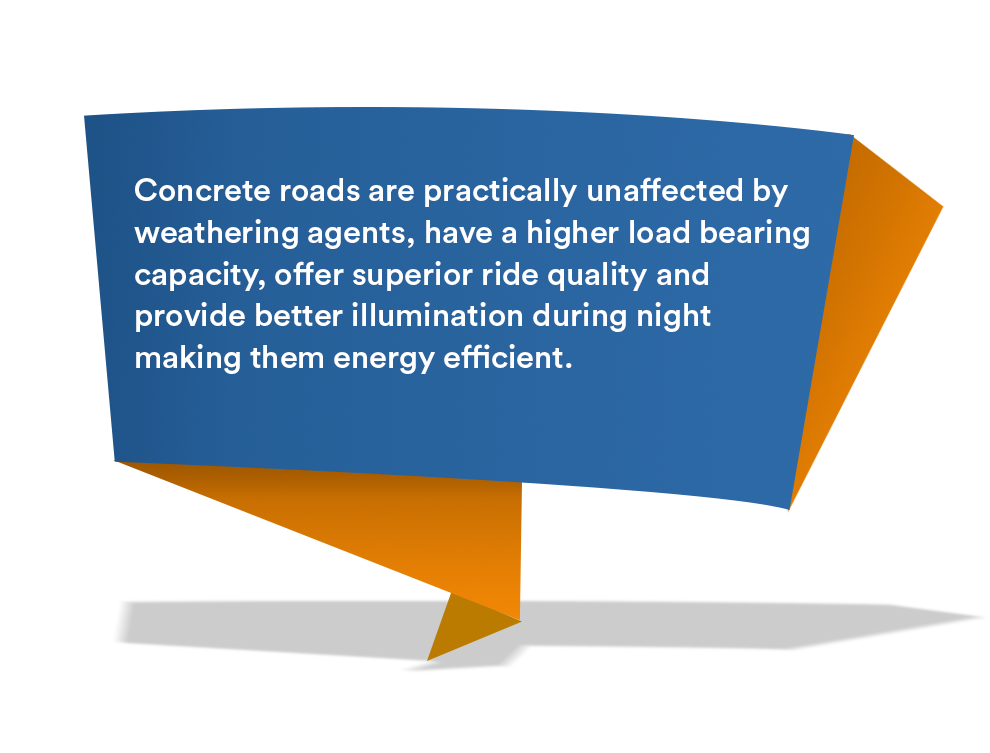Expansion of road networks is vital for the economic development and inclusive growth of a nation. Roads bring multiple economic benefits by linking buyers to sellers, allowing workers to go to jobs, taking students to school etc. They are indispensable for the development of a nation.1
India is currently on a path of developing robust road infrastructure. Under the Bharatmala Pariyojana, a total road length of 64,942 km is being developed.2 Considering the significant benefits, which such a large road network can bring in the long run, it becomes crucial that a material is chosen, which is durable and has a long life. Concrete roads offer such a solution.3
Concrete roads are practically unaffected by weathering agents, have a higher load bearing capacity, offer superior ride quality and provide better illumination during the night making them energy efficient. It is an ideal choice for the construction of highways.4 It is for these reasons that major highways such as the Mumbai-Pune highway and the Yamuna Expressway etc, have been made using concrete.5 In fact, concrete roads have been in India since the time of the British. Mumbai’s Marine Drive was built as a concrete road. The road needed repair only in 2012, about 72 years after its initial construction. This highlights the long term advantage that concrete roads offer.6
A number of myths have proliferated around concrete roads, which have been listed below along with the correct reasoning for busting the myth.
| S no | Myth | Fact |
|---|---|---|
| 1 | Concrete roads are expensive |
|
| 2 | Concrete roads are skid prone | If appropriate construction methods such as choosing substantially harder fine aggregate as compared to the cement paste and creating a deep texture with transverse or longitudinal grooves, can be engaged, then incidents of high and low speed skidding can be substantially reduced8 |
| 3 | Concrete roads offer a noisy ride | The noise when moving on concrete roads is caused due to textured brushing and transverse or longitudinal grooving on the surface. The cause of the noise is not the concrete itself but the texture of the concrete roads. While these grooves create some tyre noise, they offer an excellent riding surface under all weather conditions and are practically non slippery leading to a more stable ride9 |
| 4 | They make tyres burst | This myth doesn’t hold any factual ground as the reasons for tyre bursts are the same for both concrete roads and flexible pavements. Tyre failure is caused due to reasons such as underinflated tyres, which leads to excessive tyre flexing increasing the contact patch with the road. Other reasons include hot tropical or subtropical temperature across India, and direct impact due to obstacles, bumps and potholes. All these factors contribute to increased weathering and air temperature of the tyre, which could potentially slash the tyre surface leading to tyre failure10 |
| 5 | They are liable to crack and warp due to temperature variations |
|
| 6 | Take a long construction time and cannot be opened to traffic quickly | Use of right technology and innovation can ensure that concrete roads are laid in record times. Using Prestressed Precast Concrete Pavement (PPCP) technology, Nagpur Public Works Department built a 100 metres concrete road in 6 hours. A world record was created when a 2.5 km four lane stretch on Delhi Vadodara Mumbai expressway project was completed in 24 hours13 |
The benefits offered by concrete roads far outweigh the benefits offered by its alternatives. With significantly large scale road infrastructure being developed in India, it is important that concrete roads are increasingly used to create long term durable riding surfaces, which will be a win-win solution for all the stakeholders involved. Under such a scenario, regular stakeholder consultation become crucial to develop a holistic perception in the matter.
